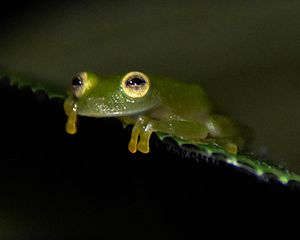Hyalinobatrachium chirripoi facts for kids
Quick facts for kids Hyalinobatrachium chirripoi |
|
|---|---|
 |
|
| Conservation status | |
| Scientific classification | |
| Synonyms | |
|
Cochranella chirripoi Taylor, 1958 |
The Hyalinobatrachium chirripoi is a special type of frog known as a glass frog. It gets its name because its belly is so clear you can see its insides! This amazing frog lives in parts of Ecuador, Colombia, Panama, Costa Rica, and Honduras.
Its scientific name, chirripoi, comes from the Chirripó people who live near where this frog was first discovered in Costa Rica. People also call it the Suretka glass frog.
Contents
What Does the Suretka Glass Frog Look Like?
These cool frogs are quite small. Adult males are about 24–26 mm (0.9–1.0 in) long, which is about the size of a large paperclip. Females are a bit bigger, measuring around 26–30 mm (1.0–1.2 in).
Their skin on their back is bright green and has tiny yellow spots. But the most amazing part is their belly! It's completely clear, like glass. This means you can see their red heart, their white digestive system, and their liver right through their skin. Their eyes have a beautiful golden yellow color.
The frog's ears, called the tympanum, are not easy to see. Their fingers and toes have flat tips, and their toes are very webbed, which helps them swim and climb.
Where Does the Suretka Glass Frog Live?
The Suretka glass frog likes to live in wet, warm places. You can find them in lowland and mountain forests, and even in grassy areas below 600 m (2,000 ft) above sea level. They can also live in areas where the natural habitat has been changed a bit, especially in Costa Rica.
Adult frogs usually hang out in bushes and trees that are near forest streams. This is because they lay their eggs on the underside of smooth leaves that hang over the water. When the tiny tadpoles hatch from the eggs, they simply drop into the stream below to continue growing.
Protecting the Suretka Glass Frog
Luckily, the Suretka glass frog is common in many places where it lives. However, in some areas, it can be in danger because its home is being lost. This happens when people clear land for farming or cut down trees for wood.
The good news is that many of the places where these frogs live are protected areas. These special areas in Colombia, Panama, and Costa Rica help keep the frogs and their homes safe.
See also
 In Spanish: Hyalinobatrachium chirripoi para niños
In Spanish: Hyalinobatrachium chirripoi para niños


